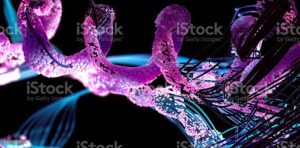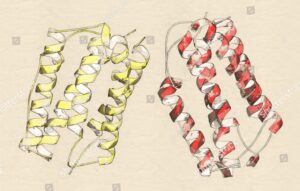This teichoic acid found in cell wall of the bacteria to the surface of the peptide glycan layer. Gram positive bacteria like genera staphylococcus , streptococcus, Bacillus, clostridium, corynebacterium and Listeria.
It don’t have outer membrane but have much thicker cell wall . Teichoic acid is discovered by Baddiley in 1933. These are found on the cell wall of the gram positive bacteria. Teichoic acid is Glycopolymer Bacteria copolymer, which is present or embedded inside the peptido glycan layers.
Teichoic acid structure:
Teichoic acid structure contain an amount of alcohols like glycerol or ribitol .It is also joined with an phosphate groups . These are glycerol phosphate or ribitolphosphate .Amino acids or sugar like glucose etc. are attach to the glycerol or ribitol group. Teichoic acid structure also consists of carbohydrates linked via phosphodiaester bond .
Teichoic acid covalently bonded to N-acetyl muramic acid or a terminal D-alanine in the tetra peptide cross linkage between N-acetyl muramic acid units of the peptido glycan layer or they can be anchored in the cytoplasmic membrane with lipid anchor.
Common structure is ManNAc(bita1 -4) GlcNAc disaccharide with one to 3 glycol phosphate attach to C4 Hydroxyl. Variation found in the long chain tail .

Classes of Teichoic acid structure:
There are generally two classes of the teichoic acid structure one is lipoteichoic acid and other one is wall teichoic acid.
1.Lipoteichoic Acid (Membrane Teichoic acid):
It cross to be peptido glycan layer. It is linked with plasma membrane and spans the peptido glycan layer. The other name of lipoteichoic acid is membrane teichoic acid. In all species of gram positive cell contains this membrane teichoic acid.
2.Wall teichoic acid :
It is linked with peptido glycan layer. Wall teichoic acid is found in some species of gram positive.

Function of Teichoic acid :
- Flexibility to the cell wall. As the teichoic acid is negative in charge , it attracts cations such as calcium and potassium . It may help in the transport of the cations in to or out of the cell. This provides the flexibility to the cell.
- As the teichoic acid structure shows role in cell growth. By breaking beta bond between N-acetyl glucosamine gives the ability of cell growth.
- It servers as an antigen ,which help to difference between two gram positive bacteria.
- It contributes negative charge to the cell wall. This negative charge help in the transport of the cations to go in and out of the cell.
- Lipoteichoic acid acts as a receptor in gram positive bacteria.
As an Antibiotic drug Target of teichoic acid structure :
- This acid was proposed in the year 2004.
- Again it was reviewed in 2013, which gives new more specific part .
Biosynthesis of teichoic acid structure :
Enzymes involved in the biosynthesis of WTAs have been named for the teichoic acid structure is given below. Their main roles are
TarO:
TarO is present inside the inner membrane. It is connecting between GlcNAc to a biophosphoundecaprenyl in the inner membrane. biophosphoundecaprenyl is shortly called Bectoprenyl.
TarA:
TarA formed via beta- linkage. It connects between ManNAc to the UDP- GlcNAc.
TarB:
TarB connects between glycerol 3-phosphate and C4 Hydroxyl of ManNAc. Only one glycerol 3-phosphate add in to it .
TarF:
TarF Connects between glycerol- 3 phosphate and glycerol tail. Here More glycerol-3 phosphate adds which is different from TarB because in TarF only one glycerol 3 phosphate add in to it.
TarK:
TarK connects ribitol-5 – phosphate units .It mostly found in Bacillus subtilis is W23 for Tar production but s-aureus has both function in the same TarL and TarK enzymes.
TarL:
TarL forms the longest form of ribitol-5- phosphate tail.
Following this all the synthesis are the ATP binding cassette transporters TarGH flip the cytoplasmic complex to the external surface of the inner membrane. TagTUV are one type of enzymes that are link this product to the cell wall. The enzymes TarL and TarJ are generate the type of substrates that leads to the tail of the polymer. Many types of protein are found in conserved gene cluster.
In 2013 , identification of different types of more enzymes that attach unique sugars to the WTA repeat units. A set of transporters and enzymes named as DltABCE that adds alanine to both the wall and lipo teichoic acids were found.
So here the set of genes are named “Tag” instead of “Tar” in Bacillus subtilis 168, which lacks both TarL and TarK enzymes. Here we should have to know that TarB , TarF, TarL, TarK all bear some type of similarities to each other and belong to the same family. By the measure role of Bacillus as the main role in model strain , some linked UniProt entries are in fact the “Tag” ortholog as they are better annotated. The “similarity search ” may be used access the genes in the Tar-producing Bacillus substilis W23. The other name is BACPZ.
Also, please click to know about Glycolic Acid Structure and Acetylsalicylic Acid Structure.
Hi…..I am Upasana Nayak. I have done my Masters in Chemistry. I am working as a Chemist in a mining company along with that working as a Subject Matter Expert in Lambdageeks for Chemistry subject